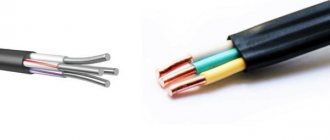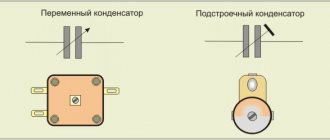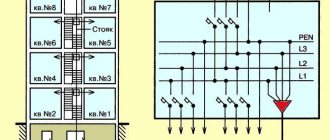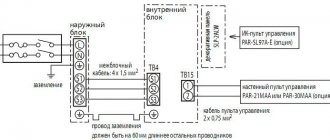Causes of fluctuations
Why do such jumps occur? There are many reasons for this. These may not only be emergency problems. The reason for such jumps can also be natural or man-made. The main ones are:
- Disconnecting several powerful electrical appliances from the network at once. An apartment building uses a huge amount of powerful electronic equipment. If the house has old wiring, it is very dangerous. But these kinds of power surges also happen in new-style houses. This is justified by the fact that the load was not designed for the use of strong devices, taking into account that the electrical network in the new house is old. This happens as follows: when consumers turn on, the electrical network senses a drop in current. If electrical appliances or one powerful device is turned off, sudden surges occur.
- Unstable operation of the transformer substation. Transformer substations, which distribute and transport energy in electrical networks, were usually built a very long time ago. Therefore, the equipment that is installed and used there has a lot of wear and tear. In addition, most transformers, due to the increasing use of electricity, operate under constant overload. As a result of this, unexpected failures occur at substations, and, consequently, voltage drops and surges.
- Electrical network and failures in its operation. All cities and villages in the country are surrounded by a huge number of power lines. Today's world cannot exist without electricity. But the power grid, which was built many years ago, is not improving, but on the contrary, is becoming unusable. This means that accidents, line breaks and short circuits are a completely normal reaction of transmission lines, the consequences of which do not bring anything good. Such accidents lead to consequences such as power surges and surges.
- Zero break or weakened grounding. The parameters of the electrical network may also change due to a zero break. This is one of the most dangerous accidents that causes a large change in the transmission line. As a result, all electrical equipment that is plugged into the outlet burns out. Even the one that doesn’t work, but is simply connected.
Causes of voltage surges
There are a sufficient number of objective and subjective reasons of a natural, emergency and man-made nature for the occurrence of voltage surges in electrical networks. Below we will try to list the main ones.
1 reason for the appearance of a “voltage surge” is the simultaneous shutdown of powerful household appliances
The reason for the jump in current parameters lies in our home. Today, the modern home is very saturated with powerful electrical appliances. In houses with old wiring this is very dangerous. But even in new houses it often happens that the load cannot be designed for the use of very powerful appliances due to the connection of the entire new house to the “old electrical networks”. In practice, the following often happens. Several powerful electrical appliances turn on in the house, this leads to a drop in the current parameters in the network. When a powerful appliance or several powerful electrical appliances suddenly switches off, a sharp jump occurs.
2nd reason for the appearance of a “voltage surge” is instability in the operation of the transformer substation
Most of the transformer substations providing power supply in distribution and transportation networks were built quite a long time ago. The equipment installed at these substations today has significant wear and tear. In addition, many substations are operating under heavy load due to increased electricity consumption. As a result, equipment malfunctions occur at substations, leading to surges.
3 reason for the appearance of “voltage surges” - accidents in transmission electrical networks
Hundreds of thousands of kilometers of power lines envelop all the cities and towns of our country. Each house and each plot has a power supply line. To paraphrase a well-known phrase from a popular film, we can say that without electricity today it’s “not going there”, “and not going there”. Power lines built decades ago are not getting any younger today. This means that there is a possibility of breaks and short circuits on transmission lines. Such accidents can trigger large surges in electrical voltage.
4 reason for the appearance of “voltage surges” is a break in the “zero”
This is perhaps the most common and dangerous type of accident, causing a very large overvoltage. Every year, thousands of people suffer damage due to a primitive “zero break.” If the “zero” breaks, voltage may appear at the “zero” contact in all sockets in the house. This causes all electrical appliances plugged into the outlet to burn out. In this case, even devices “turned off” using the remote control burn out. The reason is trivial - the weakening of the “zero” contact in the general switchboard of the house. Moreover, if the contact is not constant, it appears and then disappears, then very strong jumps occur.
5 reason for the appearance of “voltage surges” is weakening of grounding
Grounding electrical devices plays an important role in ensuring the safe use of devices. If the insulation of electrical devices is damaged, voltage is often transferred to the device body. In this case, “grounding” plays the role of draining this emergency current. If the quality of grounding deteriorates, the likelihood of surges in current parameters increases significantly.
6 reason for the appearance of “voltage surges” is significant network overload
Electrical equipment mounted at electrical substations is designed for a specific maximum power value of the connected load. Currently, there is a very large increase in electricity consumption in our homes. The first reason here is the construction of new large buildings on the site of old small houses. Instead of 10 apartments, you get 100 apartments in one large building. The second reason is the increase in the number of powerful electrical appliances used. Look at the facade of a modern apartment building; there are 200 split systems on it. And this is an additional 400 kW of power. Plus 100 microwave ovens, plus 100 electric heaters, plus 100 washing machines, plus 100 electric water heaters, a very large total power of the house accumulates. At the same time, substations experience significant overloads, and surges in this area of the city are inevitable.
7 reason for the appearance of “voltage surges” is poor quality of installation and materials of electrical house wiring
If something does not work in the electrical circuit, then you need to look for a bad contact. This is the first rule of electricians. Poor contact in a socket or electrical socket can occur due to poor installation of these devices or due to the use of cheap alloys for the contact plates of these devices. Poor contact causes sparking. And sparking is the epicenter of electrical voltage surges and strong impulse noise. To avoid power surges, it would be good not to use sockets at all, but this does not happen. This means that every switching on or off of a powerful electrical device is a new surge in voltage in the network.
8 reason for the appearance of “voltage surges” is the inclusion of industrial equipment in the adjacent power transmission network
Large and systematic power surges in the network are observed near large industrial facilities. Turning on a powerful electric motor generates large starting currents. These currents can "return" to the electrical network in the form of a large reactive load. And although special starters and additional surge protectors must be installed on such equipment, the generation of electrical surges cannot be avoided. And you don't have to live next to a large metallurgical plant to get unpleasant electrical surprises. To generate a good voltage surge, proximity to a pumping station, powerful ventilation equipment, a car workshop or a large supermarket will be enough.
9 reason for the appearance of “voltage surges” is the “flickering effect”
Voltage surges can be systematic. A possible reason for such surges may be incorrect operation of control equipment in electrical appliances. Regulators of electrical appliances must turn on and off the device or part of it to control certain parameters. An example of the simplest regulator is the temperature regulator of a heating device or electric iron. When the desired element temperature is reached, the device should turn off. It often happens that the regulator operates very often, this leads to wear on the contacts of the switching device. Worn contacts begin to generate current surges. In this case, you can see periodic jumps on the voltage graph.
10 reason for the appearance of “power surges” is lightning striking transmission lines
The most spectacular and most powerful reason that generates gigantic overvoltages and surges is lightning striking power lines. I think everyone has seen lightning strike power lines and metal transmission poles. It must be said that the history of the creation of electrical appliances is closely connected with lightning. The first experiments in the use of electricity were carried out with lightning energy. Modern power transmission systems have lightning protection, however, it is not possible to completely avoid the appearance of large pulses in the network. Powerful lightning discharges generate large overvoltages, which spread along the transmission line and can reach the end consumer. And although the impulse from a lightning strike lasts hundredths or thousandths of a second, this frantic energy of thousands of volts is enough to cause great damage to electrical equipment.
11 reason for the appearance of “voltage surges” - high voltage coming from tram and trolleybus contact lines
A situation where a contact tram or trolleybus power line breaks occurs in the city several times a month. The cause may be a strong gust of wind or construction work, or a tree falling on a transmission line. In this case, one of the wires of the contact line may catch or completely fall onto ordinary power lines. In this case, voltage surges of hundreds of volts can be observed in the network. There are cases when such an accident leads to the burning of all electrical appliances in several houses near the accident. At the same time, if a protective shutdown does not occur, then overvoltage can even cause the devices to catch fire.
12 reason for the appearance of “voltage surges” is welding work
Carrying out welding work using electric welding always leads to large voltage surges throughout the entire network. And if in the city this phenomenon is rare, then in villages and towns it occurs with enviable regularity. Someone is welding a fence, someone is throwing away a refrigerator that burned out due to a large power surge. In this case, welding machines are often connected directly to the entrance of wires into the house, that is, bypassing all protections. Each welding arc in this case generates a large jump in current parameters in the network.
Thus, we can distinguish several groups of causes of power surges :
- Voltage surges are generated due to poor quality equipment and installation of electrical equipment and electrical wiring;
- Voltage surges appear due to turning on or off powerful equipment or powerful electrical appliances;
- power surges are caused by natural factors, lightning strikes, strong winds, floods;
- voltage surges are caused by violations of the rules for operating devices and equipment or by an insufficient amount of preventive work carried out;
- a surge in electrical voltage is caused by disruptions during construction and welding work;
- The power surge occurred due to man-made accidents.
Effect of low voltage on electrical appliances
When there is no voltage in the network, devices that have an electric motor or compressor are most vulnerable. This is most of the household tools, refrigerators, washing machines, pumps. They receive the main damage when the engine starts. Such equipment has weak built-in protection that cannot cope with voltage drops.
Abnormal operation affects the operation of the equipment and can reduce its service life. If the voltage in the network has dropped, the user can notice this in household appliances and appliances. Extraneous sounds may occur when the refrigerator and air conditioner are operating. Heating devices take longer to reach the desired temperature. A person suffers from flashing lights and insufficient lighting.
A decrease in voltage has a detrimental effect on devices and household appliances:
- deterioration of engine starting characteristics;
- increase in current at startup;
- changing the basic parameters of electrical appliances;
- reduction of luminous flux of incandescent lamps;
- an increase in current strength, as a result of overheating of the wires, destruction of the insulation;
- malfunctions of complex electronic equipment.
A solution book for a collection of physics problems for grades 7-9, Peryshkin A.V.
1008. Express the voltage in volts: 400 mV; 80 kV; 200 mV; 300 mV.
1009. Is it possible to obtain different current strengths from the same current source? How to do it?
It is possible by connecting a variable resistance to the network.
1010. The resistance of the lighting device is 1.2 Ohm, the voltage is 48 V. How much current passes through the device?
1011. Determine the strength of the current passing through an incandescent light bulb if the voltage on it is 110 V, and its resistance during combustion is 80 Ohms.
1012. The voltage on an electric iron is 220 V, and the resistance of its heating element is 50 Ohms. How much current flows through the iron?
1013. An electric bell with a resistance of 480 Ohms is connected to an electrical network with a voltage of 220 V. What is the current flowing through the bell?
1014. The current strength in the hair of a light bulb is 0.8 A. The resistance of the hair in a heated state is 275 Ohms. Find the voltage at which the light bulb burns.
1015. A metal wire with a resistance of 20 Ohms carries a current of 0.2 A. Determine the voltage at the ends of the wire.
1016. An ammeter connected to a circuit with a nickelin wire with a resistance of 2.5 Ohms shows a current strength of 1.2 A. What voltage will the voltmeter connected to the ends of the nickelin wire show?
1017. A current of 0.5 A flows through an electric light bulb with a resistance of 440 Ohms. At what network voltage does the light bulb light up?
1018. The average resistance of the human body is 50 kOhm. What voltage is dangerous for humans if it is known that a current of more than 0.01 A can be fatal?
1019. In the tram network, the voltage is 575 V. The average current passing through the winding of the tram motor is 71 A. What is the winding resistance?
1020. The current strength in an electric boiler is 5 A at a network voltage of 110 V. Determine the resistance of the boiler.
1021. What resistance does a voltmeter rated at 127 V have if a current of 0.02 A flows through it?
1022. Determine the resistance of the filament of an incandescent lamp if a current of 0.12 A flows through it at a voltage at the ends of the network equal to 120 V.
1023. The current in the lamp is 0.25 A at a voltage of 120 V. What is the resistance of the burning lamp?
1024. What should the voltage be at the ends of a section of the circuit so that the current in the conductor is equal to 1.0 A, if at a voltage of 3 V the current in the same conductor is 0.5 A.
1025. The voltmeter shows a voltage of 2.5 V at the ends of a section of a circuit with a resistance of 1.4 ohms. An ammeter connected to the same circuit shows a current of 1.8 A. Is the ammeter reading correct?
1026. Graphically depict the dependence of current on voltage in a section of the circuit.
1027. Is it possible to connect an ammeter with a resistance of 0.02 Ohm, designed for a maximum current of 10 A, directly to a battery, the voltage at the poles of which is 2 V?
1028. Using the current versus voltage graph (Fig. 100), find the resistance.
1029. An ammeter connected to a circuit shows a current of 1.8 A. Are the ammeter readings correct if a calibrated voltmeter shows a voltage of 2.5 V at the ends of a 1.4 Ohm resistance?
1030. Determine the resistance of the tram car motor winding if, when tested with a voltage of 57.5 V, it turns out that the current in it is 71 A.
1031. What is the resistance of the filament of a light bulb if a current of 0.12 A passes through it at a voltage at the ends of the filament equal to 120 V?
1032. Determine the voltage at the ends of a conductor whose resistance is 20 Ohms, if a current of 0.2 A flows through the conductor.
1033. What voltage will be shown by a voltmeter connected to the ends of a nickel wire with a resistance of 2.5 0 m, if the ammeter connected to the circuit shows a current of 1.2 A?
1034. A voltage of 1 V is applied to a mercury column 100 cm long and with a cross section of 1 mm². Determine the current strength. Try to answer why the resistance of a mercury column with a length of 106.3 cm rather than 100 cm was chosen as the unit of resistance.
- Like
Possible solutions to the problem
When energy companies ignore complaints from citizens regarding voltage drops, do not install a powerful transformer and do not change the cross-section of wires taking into account the level of consumption, you have to make a decision yourself.
One solution is to install a three-phase power supply system, which will require permission from the sales company. After approval, a switch is installed at the electricity input, which makes it possible to use the least loaded phase.
Let us indicate other ways to solve the low voltage problem:
Purchasing and installing a stabilizer will help cope with the task, provided there is a slight drawdown. It is worth remembering that the stabilizer is not cheap, and if neighbors use similar equipment, its functionality may be useless.
Installation of a step-up transformer with the appropriate parameters. If the voltage is unstable, a situation may arise when the step-up transformer brings its value to critical levels, which will certainly lead to damage to household appliances. To prevent such an outcome of events, a protective relay is installed that breaks the electrical circuit when the limit is reached.
Capable of providing optimal current parameters and power supply to any consumer during a power outage. The essence of the converter's operation is similar to a regular uninterruptible device for a PC, but it has more power.
The incoming voltage values can be monitored using a low voltage current sensor. Different devices have differences in the upper and lower thresholds, so when choosing a specific model, it is worth taking into account the individual characteristics of your own electrical network.
It is important to remember that an independent solution to the issue of lowering the voltage in the network, provided that the transformer is weak and the cross-section of the wires is insufficient, is hardly possible.
In this situation, it is better to act together (one entrance, house or even street) and submit a collective application to the company supplying electricity. You can try to solve the question of what to do when the voltage in the network is low using the methods indicated above, provided that the culprit of the fall is the consumer himself.
What can cause the voltage to drop:
- - transformer substation.
Transformer substations have been installed throughout Russia, the vast majority of them were installed back in the days of the USSR, while the calculation of the load on them was carried out based on completely different electrical appliances and their number. The age of operating transformers also plays an important role, which adversely affects the quality of the power supply. But it is worth noting that the engineers of that time laid down a significant margin of safety, both in terms of power and mechanical strength. - - power lines.
The situation is similar with transformer substations. The diameter of the cores and the cable material (aluminum) often cannot withstand increased electricity consumption, and numerous twists of steel over time bring its own losses in quality. At the moment, the aluminum cable is being replaced with copper cable, which is more suitable for loads. - - difference in power consumption between phases.
As you know, there are three phases in the power supply system. Mostly, one of the phases is connected to an apartment or private house. If there is a significant excess load on one phase relative to the other two, then a phenomenon called phase imbalance occurs, which provokes an increase or decrease in voltage.
Everything written above can be present either separately or in combination. Even if you repair or replace one of the components, the situation can only partially improve. There is one more nuance in power supply networks: at the end of the line from the transformer substation, electrical consumers work in more difficult conditions than consumers located closer to the transformer substation (They can consume more power and at the same time the quality of the power supply will be better.
The main reasons for the decrease in network voltage
Is it always 220 in our network? The question, of course, is rhetorical; very often the voltage in the network does not meet the standards and is either too low or too high. Here is a list of the main causes of low voltage:
- low voltage in the power line;
- insufficient power of the transformer installed at the substation;
- voltage imbalance across phases on the line from the transformer to the house;
- problems in the switchboard, small cross-section of wires in the wiring.
The main ways you can act
At the same time, we will consider the causes of low voltage and ways to eliminate them for each individual situation.
If such an unpleasant situation arises, first of all try to find out - are small indicators typical only for your consumption area or are they also observed in your neighbors’ networks? If the voltage in neighboring houses and apartments is normal, you need to look for the cause of the problem in your own electrical wiring.
You will first need to measure the input voltage, having first turned off the machine. If the indicators are below the norm established by GOST (±5 and ±10% of the nominal 230 Volts, which corresponds to values of 207-253 V), immediately contact the energy sales services. If the input values are normal and the voltage drops after connecting the load, you will have to troubleshoot and fix the problem yourself. In such a situation, only the three above reasons can be present. Checking the correct connection of the circuit breaker is a mandatory first step to identify the present fault.
Low voltage may be due to insufficient contact with the wire at the top terminal. The machine body needs to be replaced if a visual inspection determines that it is melted. If replacement is necessary, it is necessary to tightly tighten the wires in the clamps of the new machine.
If there is no visible damage in this area, the next step is to check that the cross-section of the water wire is suitable for the load required for the operation of all devices in the building. Insufficient parameters for this indicator are the reason for the voltage drop at increased loads.
Having made sure that the cross-section of the home wiring fully meets the design requirements, you need to proceed to inspecting the branch line to your input from the main line. Installation by twisting almost always causes low voltage due to a branch made in a poor manner. A decrease in voltage parameters is a consequence of an increase in resistance in the problem area that occurs due to poor contact. But even in the case of using clamps, malfunctions may occur. Carefully inspect the condition of the housings and check the clamps using the load connection method. When the case heats up or sparks appear, there is only one way out - immediate replacement of this element.
It is much more difficult to fix the problem if the low voltage is not your fault, but due to poor quality services of the energy supplier. In such a situation, everything happens with certain, and often considerable, difficulties. How the complaint process works, where to call and what to demand is a topic for another discussion. Let's consider measures that can ensure normal voltage in your electrical network.
One of the reliable and proven methods is connecting a stabilizer. Using this device, the voltage parameters can be increased to the required 220V from the 140-160 Volts available in the network.
Most consumers are inclined to favor this option as the optimal way out of the current situation.
The use of electric heaters during the heating season is almost universally associated with a voltage drop. Therefore, the stabilizer, taking into account its relatively inexpensive cost, will be the best protection for household appliances from voltage surges.
A more expensive, but at the same time very effective, method is to purchase an uninterruptible power supply. During a sharp drop in voltage, the autonomous power supply mode allows you to eliminate the problem without any difficulty. Almost all such emergency systems operate on 140 Volts, which in this case will be the optimal solution. The only negative is the high price. A 5-kilowatt model in 2015 prices will cost a minimum of 80,000 rubles.
← Previous page Next page →
Complaint about changes
The supply of electrical energy to consumers that does not meet the requirements of the standards becomes the basis for filing a complaint about power surges.
Causes
The reason for complaint is the supply of electricity of inadequate quality (with low or high voltage, its drops and surges). This often leads to damage to household appliances and even fires, which poses a threat to people's lives and health.
What do power surges lead to, using the example of Sochi residents:
Material on the topic: How to complain about the quality of tap water.
Household appliances have broken down: what to do?
If voltage surges lead to the failure of household appliances (refrigerator, washing machine, oven, microwave oven, computer, TV, etc.), you must follow these steps:
- try to at least visually clarify the cause of the breakdown, and if there is a suspicion of a connection with surges, move on to the next point (the fact that there is a relationship is indicated, for example, by the extinction of the light, a sharp sound from the device immediately before the breakdown);
- call the emergency service and invite representatives to draw up supporting documents;
- assess the damage caused (usually by contacting specialized institutions, such as repair shops);
- draw up a claim for damages and send it to the culprit (electricity supplier);
- if the damage caused is not compensated, then it is necessary to prepare a statement of claim to the court (submitted at the plaintiff’s place of residence and is not subject to state duty).
All documents collected during the above steps before going to court must be attached in copies to the claim.
To protect yourself from unpleasant situations with horse racing, you need to quickly respond to the delivery of low-quality services by filing complaints. You can also use special devices - uninterruptible power supplies and stabilizers.
Rice. 2. Voltage stabilizer
What to write in a complaint
Table 2. What to write in a complaint
| Short description | |
| Recipient | Name of the authority where it is addressed |
| Applicant (representative) | Personal details, address and telephone number, if available - email |
| Title of the document | Complaint (claim) |
| The essence | Briefly describe the reason for your request |
| Requirement | What is the applicant asking for? |
| Application | Additional materials (acts, photographs, certificates) |
| Date and signature | At the end of the claim, the claim is made by the applicant or representative |
Attention! In order to detect the failure of household appliances, it is necessary to call the emergency service. Be sure to keep a copy of the completed act for yourself
You can use the sample below to file a claim.
Where to contact
The complaint can be sent to:
- management organization (residents of apartment buildings);
- resource supply company (residents of the private sector and apartment buildings);
- Department of Housing and Communal Services, Housing Inspectorate;
- Rospotrebnadzor;
- prosecutor's office
If all of the above authorities do not solve the applicant’s problem or he suffered harm (for example, a TV set burned down), which the culprit refuses to compensate, then he has the right to file a lawsuit. In this case, it is necessary to attach all the collected materials: copies of claims, responses to them, an act, a certificate from a repair shop, etc. When there are several victims during a certain period (for example, residents of the same entrance), you can draw up a general statement of claim.
Ways to complain
You can complain:
- orally (for example, by first calling the management organization or electricity supplier);
- in writing (by sending a claim by registered mail);
- through the Internet.
Sometimes the solution to a problem can happen after a phone call. But more often a written claim or an appeal via the Internet is necessary.
Internet
Dissatisfied consumers with Internet access have the right to use special sites. Residents of Moscow and the region can leave a request on the portals “Our City Moscow” or “Dobrodel”. You can submit a claim on the RosZhKH website.
Rice. 3. Report the problem on the “Our City Moscow” portal by selecting the “My Home” section.
What should an energy consumer do?
The simplest way to protect against power surges is to turn off devices in a critical situation. Such devices are based on voltage control relays of the RN type and electronic control circuits. If there is an excessive drop in the network, household appliances turn off, and when they return to a stable state, they automatically turn on again.
Such devices are mounted directly at the entrance to the electrical appliance. With their help, most often, long-term operating devices (refrigerators, washing machines, etc.) are protected. If there are frequent and long-term fluctuations in the network, care must be taken to continuously maintain its parameters within normal limits. For these purposes, special devices are used - voltage stabilizers.
If the fluctuation occurs within the operating range, then the device constantly maintains the voltage at the nominal value (220 V) with a deviation of no more than 1-2%. When jumps exceed the permissible values, the device turns off and turns on again when returning to operating limits. Modern stabilizers have an operating range of about 160-250 V.
If voltage drops are caused by internal reasons (for example, poor quality wiring), then you need to call a professional electrician to correct the situation. He will find the reasons and eliminate the malfunctions. It’s another matter when there are network disturbances and a voltage that does not meet GOST requirements is supplied to the apartment’s input. If such cases are recorded frequently, then you should exercise your right as a consumer of the service.
Where to complain?
If you have a complaint about the quality of power supply, you can contact:
- management company;
- territorial power grid company;
- municipal housing and communal services department;
- Housing inspection;
- Rospotrebnadzor.
You can complain by visiting the organization in person, by letter or via email. Procedure:
- submitting an application to the organization servicing the house and calling an electrician;
- drawing up a report on deviations from the norm by an electrician;
- submitting an application with a report attached to the management company with a request to rectify the situation;
- if refused, send a complaint (claim) to the supervisory authority.
How to file a complaint?
If the tenant refuses to eliminate the violations, he has the right to file a complaint with any of the above authorities. The basis for its design is the Law “On the Protection of Consumer Rights”, Decree of the Government of the Russian Federation dated 05/06/2011 No. 354 and GOST 32144-2013, which establishes electricity quality standards. The complaint is submitted in writing in free style. Some points are mandatory:
- Name of the organization and full name of the person to whom the claim is being written.
- Full name, passport details and address of the person filing the complaint.
- Reasons for appeal and complaints with references to the legislation of the Russian Federation.
- Finally, you need to describe your requirements.
- Add date and signature.
It is important to clearly indicate the violations identified.
The following claims can be considered justified:
- excessively low or high voltage;
- long periods of unstable voltage and its complete loss;
- signal frequency deviation from the norm;
- the appearance of impulse voltage.
The consumer has the right to make the following demands:
- Tariff reduction by 0.15% for each hour of supply of electricity of inadequate quality (Resolution No. 354).
- Compensation for losses in the event of failure of household appliances due to a sudden power surge.
The complaint is accompanied by an act of violations, a report or a certificate from the repair shop about the failure of the equipment.
We do not recommend completing the documents yourself. Save time - contact our lawyers by phone:
8 (800) 350-14-90
In what time frame should it be responded to?
The organization responsible for the power supply of the house is obliged to respond to the complaint within 3 days PP 354, if the complaint is filed with a government organization, then up to 30 days, Federal Law-59 Art. 12. To clarify the causes and assess the damage, she has the right to send a special commission, as well as attract independent experts. The corresponding condition assessment report is sent to the applicant.
What does low voltage in the network lead to?
- — significant deterioration in starting conditions for all types of engines and engine-based devices;
- — when starting the electric motor, the starting current increases;
- — overheating of the wires up to the melting of the insulation and the possibility of fire from a short circuit;
- - reducing the brightness of the lamps or their constant blinking, which leads to discomfort in living in the house;
- — reduction in the service life of household electrical appliances;
- — unstable operation of power-sensitive devices;
- — significant deterioration in the performance of electrical appliances.
All this together causes significant damage to all household appliances in the house. Televisions, computers, lamps, air conditioners, vacuum cleaners, refrigerators and other consumers of electricity receive great damage not only during startup, but also during normal operation. Devices with a switching power supply suffer a little less, but they also experience incorrect operation and deviations in modes. Ultimately, all this affects a person: heating devices take more time to heat up, electrical appliances with a motor operate with more noise, the refrigerator compressor may not start (i.e. food will defrost), lighting becomes dimmer, which can affect mental health. and the physiological state of a person or, at a minimum, worsen the comfort of living indoors.
Can damage caused by a power surge be compensated?
What to do in case of power surges and is it possible to compensate for damage to damaged household appliances? This is possible, the approximate procedure is as follows:
Important! If a power surge occurs in your presence, immediately call emergency services, report the incident and request that a report be recorded. Call the emergency team, which will be able to record the fact of a fault in the power supply on the spot.
In the future, this measure will serve as evidence in court.
- Determine who is responsible for causing the damage. Typically, this is one of two organizations: • an electricity supply company; • a company that services home electrical networks. To fulfill this point, you must write a statement to both organizations and demand a response indicating the reasons for the network problems. The organization has 30 days to submit a response. To determine the causes of damage, companies may create special commissions or engage third-party experts who will examine the condition of power supply networks and failed equipment. One copy or a copy of the inspection report is sent to the applicant.
- Take the damaged household appliance to a service center and ask for an opinion on the causes of the malfunction and the possible cost of repair. You can have the damage assessed by an expert. The cost of this service must subsequently be included in the statement of claim.
- Send a written request to the person responsible for the damage demanding compensation for the damage. Please attach copies of expert reports and inspection reports to your application.
- If the guilty organization (or a specific person) refused, or did not respond at all to the appeal within 30 days, then the next step is to file a claim in court under Article 17 of the Federal Law “On the Protection of Consumer Rights”. Another option for this action is to contact the prosecutor’s office with a request to protect violated rights. In this case, the claim will be filed by the prosecutor.
It happens that the culprit of causing harm is a specific person (for example, a neighbor), who independently carried out repairs and violated the rules for installing or operating electrical installations.
If the culprit of the damage is the electricity supply company, then the statement of claim contains a reference to Article 309, Part 1 of Article 539 of the Civil Code of the Russian Federation, Part 1 of Article 547, Articles 4, 7 and 14 of the Federal Law “On the Protection of Consumer Rights”.
If the culprit is a company that services utility networks at home, then refer to the violation of Article 309 of the Civil Code of the Russian Federation, Articles 4, 7 and 14 of the Federal Law “On the Protection of Consumer Rights”, paragraphs 49 and 51 of the “Rules for the Provision of Public Utilities to Citizens”, paragraph 5.6 of the “Rules” and norms for the technical operation of the housing stock,” paragraph 7 of the “Rules for the maintenance of common property in a residential apartment building.”
IMPORTANT: To make it easier for the judge to make a decision in your favor, additionally attach to the statement of claim evidence from neighbors who find themselves in a similar situation. To summarize the article, it should be noted that it is easier to take measures in advance to protect home equipment from voltage surges in the network than to waste time and nerves in the courts
To summarize the article, it should be noted that it is easier to take measures in advance to protect home equipment from power surges in the network than to waste time and nerves in the courts.
Poor quality electricity
The quality of electricity, according to the current regulations of the law, is determined by several basic parameters of electricity: the level of voltage deviation from established standards, voltage asymmetry in the network, dips and overvoltage. All these factors reduce the quality of electricity and may cause recalculation of the cost of power supply to a cottage or apartment.
It is important to note that problems with the quality of power supply can lead to various unpleasant consequences; first of all, poor electricity negatively affects the functionality and service life of devices connected to the power grid. There are often cases when, due to the fault of a network company that supplies consumers with low-quality services, expensive electrical equipment - computers, washing machines, refrigerators, etc. - fails.
In some cases, poor quality maintenance can even affect human health and cause emergency situations, so it is important for owners to learn to recognize problems in the electrical system based on a number of signs.
There are many different signs of poor-quality electricity supply. Among the most recognizable signs are flickering lighting fixtures, frequent burnouts of light sources, and problems in the operation of electrical equipment.
If you notice similar signs in your home, this should prompt further investigation into what caused these problems.
Problem solving
Depending on the frequency and consequences of low-quality energy supplies, the owner has the right to demand various compensations from the network operating company. The first step is to determine the extent of the problem with poor quality energy. There are two common cases in practice:
- If the consumer simultaneously received low-quality energy, which caused a breakdown of electrical equipment.
- If the network company regularly supplies the owner with low-quality energy, which manifests itself in too low or high voltage in the network, which leads to a reduction in the service life of electrical equipment.
If, due to one-time poor-quality deliveries, a consumer’s household appliances burned out, then the actions of the owner may depend on many external factors. Most often, equipment whose warranty period has expired fails due to low-quality energy, but if the warranty is valid, then in 90% of cases it will indicate that the manufacturer does not bear any responsibility in cases of failure of the device due to improper operation, and connecting equipment to a network with an inappropriate voltage level falls precisely into this category of failures.
In order to receive compensation for damage, the owner must contact the manufacturer’s service center to conduct a study, during which the cause of the failure of the device must be identified. Based on the research, the service center specialists draw up an appropriate protocol indicating the cause of the breakdown.
Based on the received report, if it indicates problems with the electrical network as the cause of the breakdown, you can demand voluntary compensation from the network company for the full cost of the failed device. The corresponding application must be submitted to the office of the operating company in two copies, so that the company’s employees put a mark on acceptance of the application on one copy. If the application is not satisfied, the owner has every right to file a claim for compensation for losses in court. In most cases, the court takes the owner’s side and obliges the network company to pay the owner not only the full cost of the failed devices, but also pay for an examination, lawyer’s services, and possibly moral compensation.
No less common situations are cases where poor-quality service provision is systematic, that is, for certain periods of time there is a constant too low or high voltage in the network.
If the quality of power supply does not meet established standards, then by law, for each hour of poor-quality service, the cost of services per month can be reduced by 0.15%. In some cases, the price may be reduced to 0 if the buyer is constantly supplied with poor quality services. The number of hours of poor service must be determined when reporting meter readings to the network company.
Current standards indicate that all consumers who receive energy whose quality does not meet the stated standards by 10% or more can count on recalculation of costs. In other words, if you often notice that the voltage level in the network, instead of 220 V, is 198 V and below or 242 V and above, you have every right to apply for a recalculation of the cost of electricity supply.
The law also specifies the rules for consumers to apply for recalculation. According to the standards, if facts of poor quality supply are detected, the owner must submit an application for an energy quality check to the operating company. After receiving such an application, the network enterprise must carry out an appropriate check within 2 hours from the receipt of the application. If representatives of the network company refuse to check the quality of energy, the owner has the right to contact another energy company with a request to conduct an independent study.
Below you can use the online calculator to calculate the cost of connecting to electrical networks:
Learn more about the causes of low voltage and methods to solve this problem
Voltage drop in power line
One of the global reasons for the voltage drop is the insufficient power generation and electrical transformation capacity in the region. Insufficient financing of the electrical industry, on the one hand, and the rapid growth of electricity consumption in recent years, on the other hand, leads to problems with the quality of power supply.
We practically cannot influence the solution to this problem; the only solution in this situation is the purchase and installation of a step-up voltage stabilizer.
Low power distribution transformer or incorrect setting
This often happens. A certain number of consumers were connected to one transformer and there were no problems with power quality. Then more new houses are connected to the same transformer or substation, and its power turns out to be insufficient, this leads to a decrease in voltage in the entire connected network. This phenomenon is often observed in holiday villages, and voltages of 180, 170, 160 and even 150 Volts are not uncommon there.
What are the solution methods? The most correct way is to replace the transformer with a more powerful one. But for this you need to have a common solution for all consumers and financial capabilities. In this case, you can individually solve the problem by installing step-up voltage stabilizers for the entire house or the desired group of devices.
Phase imbalance in the distribution network causing voltage reduction and methods of solution
The reason for the decrease in voltage at the entrance to the house may be an uneven distribution of consumers in the distribution network or “phase imbalance”. As a rule, this phenomenon is observed in rural areas, in holiday villages and the private sector. Homes on these networks are connected to the electrical grid individually as new properties are built. Often the connection is made according to the principle “it’s so convenient for the installer” or “this wire is closer.” As a result, there are more consumers on one “phase” or one “arm” of the network than on others. The voltage in this part of the power grid will be lower.
It will not be possible to correct the situation by increasing the voltage value on the supply transformer, since this will lead to an increased (or dangerously high) voltage value in other parts of this power network. The correct solution is to eliminate the uneven distribution of consumers and switch to power from another phase of the network. But often this is not physically possible. The second solution to the problem is to install a voltage stabilizer at the entrance to the house.
Problems in the home network that lead to low voltage and methods for eliminating them
The first thing to do if you have low voltage at your outlet is to find out whether the problem is internal or external.
First. The simplest thing is to find out if your neighbors have power problems. Second. Turn off the circuit breakers in the distribution board and measure the voltage at the input to the house. If the voltage is low, then the problem is in the external network. If the voltage entering the house is normal, then the problem is in the house.
Here is a list of common problems in the electrical network of a house or apartment:
- A decrease in voltage can be caused by poor contacts at the input to the distribution board or poor contacts in the distribution board itself;
- a decrease in voltage can be caused by poor contacts in indoor distribution boxes and on the sockets themselves;
- A decrease in voltage may be caused by an incorrect choice of wire cross-section in the wiring.
If you cannot identify the exact cause on your own, you should seek help from a professional electrician.
Insufficient voltage in the house - possible causes
Low voltage in the network is an unpleasant phenomenon, but many people deal with it. Poor lighting, when the light bulb only indicates its presence, is not the biggest problem. It’s worse when it’s impossible to do laundry, boil water, cook food on an electric stove, or the refrigerator works intermittently. This happens when the voltage drops to a critical value, but 180 Volts, when everything seems to be working, is also not very encouraging. Devices consume the same current as at normal voltage, and motors consume even more current, but perform their functions over a longer period of time.
According to the standards, the permissible deviation of electricity is 198–242 V
The electricity supplier is obliged to provide services that meet the standards: 220 V at the entrance to the apartment with permissible deviations of 198–242 V. Why are regulatory requirements sometimes violated? One of the reasons is the aging of power lines, their poor quality maintenance, and repairs are rarely carried out. The equipment is often worn out, outdated and does not meet modern requirements. There are also errors in planning power lines and supply lines to houses, when one phase is overloaded and the other is underloaded.
The reasons also lie in the consumers themselves. If in Soviet times there was a 6.5 A fuse under the meter, this meant that residents simultaneously consumed a maximum of 1.5 kW. Now one kettle has a power of 2 kW, but how many other household appliances and various power tools are there in a modern home? There is also seasonality in electricity consumption, which increases significantly in the cold season when electric heating is turned on. At dachas, consumption increases on weekends, the power of the networks is insufficient, and the voltage is less than necessary.











